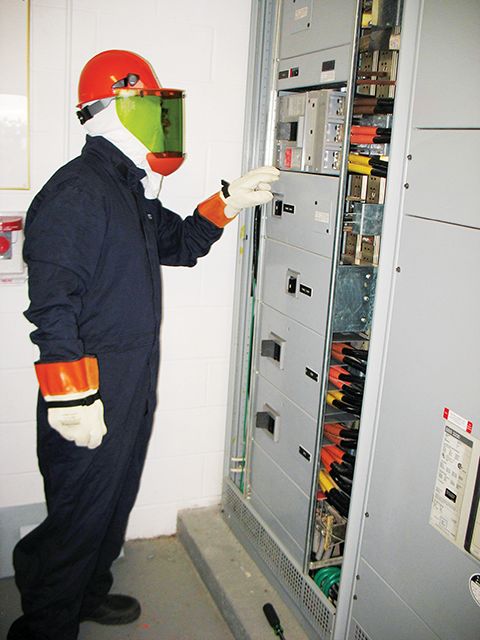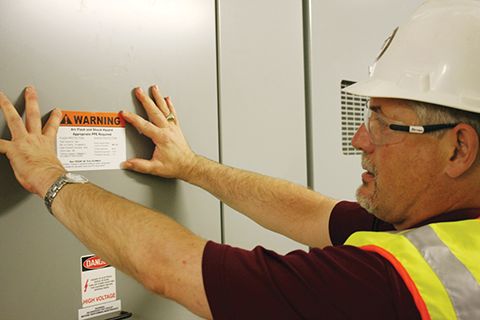
by Stephen Devon, PE, CxA, LEED AP
In the Academy Award-winning movie, portrays Matthew McConaughey as an electrician injured by being exposed to an arc flash—a type of electrical explosion produced by a combination of extreme heat, intense bright light, and a pressure wave.
While this example is from a Hollywood blockbuster, it is not dissimilar to reality. Data from the U.S. Bureau of Labor Statistics shows more than 2000 workers sustain non-fatal electrical injuries every year. Those involved in maintaining facilities have a difficult task—when it comes to the electrical system, injuries can happen if procedures are followed incorrectly or if unqualified personnel are interacting with the system. Consequently, the National Electrical Code (NEC) now requires all distribution equipment, including panelboard, switchboard, and motor disconnects, to have arc flash labels if it is to be interacted with while energized. This NEC requirement means building owners can be held liable if anyone is harmed while handling the equipment, or if equipment is incorrectly labeled.
Those involved in designing and building should have a basic understanding of what is involved in preparing arc flash labels so they can specify and qualify the product, and prepare solicitations for owners of both new and existing buildings. Although the final product is a simple ‘peel-and-stick’ label, the information on each is critical and needs to be accurate.
Installing arc flash labels can be relatively easy, but what differentiates labels is the information printed on each, along with the support functions required to achieve NEC objectives. Specifiers need to have a basic understanding of what is involved in preparing these labels to make sure they receive an end product that is accurate and includes all the services necessary to comply with the code.
Preparing an arc flash study
Whether the building is new or existing, a complete power distribution diagram must be created. If the building is new, the engineer should provide the required information. If it is an existing building, the engineer and/or contractor will need to survey the entire facility to obtain feeder sizes and lengths, equipment manufacturers, and sizes of equipment and transformers. They will then use a technical software package to calculate each piece of equipment’s various energy levels based on a category rating from 0 to 4—with ‘Category 0’ being the least severe rating and ‘Category 4’ being the most severe. In some cases, field adjustments can be made to the equipment on completion of the arc flash study to mitigate the magnitude of the energy levels and lower the category rating.
The alternative to preparing calculations is to use the tables in the 2015 edition of National Fire Protection Agency (NFPA) 70E, Standard for Electrical Safety in the Workplace. The qualifiers noted with the values in the tables often negate their applicability, and performing calculations ensures more accuracy of the final data.
Label all equipment
The results from the arc flash study will serve as the foundation for all safety procedures implemented moving forward—including the labeling of all electrical equipment. Since 2002, Article 110.16 of the National Electrical Code required all electrical distribution equipment be properly field labeled in order to warn personnel of potential electric arc flash hazards.
Based on the amount of incident energy that could be developed by a piece of equipment, measured in calories per square centimeter, labels are to be provided which indicate the arc flash boundary, nominal system voltage, and incident energy level, along with the required level of personal protective equipment (PPE).

The PPE required to interface with each piece of equipment is based on that equipment’s category level. Therefore, labeling all equipment by category is key to promoting a safe work environment.
For example, if the amount of energy is between 1.2 and 4 cal/cm2, it is considered ‘Category 1.’ When working on ‘Category 1’ equipment, personnel are required to wear an arc-rated long-sleeve shirt and pants (synthetic material is unacceptable), a helmet, eye protection, and leather gloves. ‘Category 4’ equipment, on the other hand, allows up to 40 cal/cm2 and requires much more cumbersome and expensive PPE, including heavier arc-rated clothing, overalls, a hood, gloves, a hard hat, a face shield, and ear protection. Anything over 40 cal/cm2 is considered ‘dangerous,’ and must be labeled as such, and should not be interacted with while energized regardless of available PPE.
If equipment is not labeled, building personnel will be unaware of the level of equipment they are dealing with, and therefore be ill-prepared to do their jobs safely.




